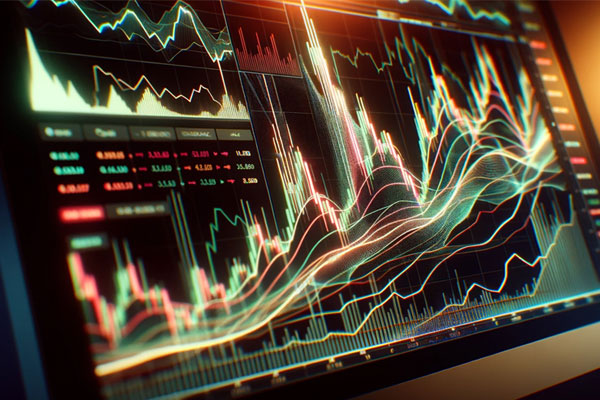Trading signals, at their core, are triggers for action in the stock market or other trading platforms. These signals are recommendations or strategies to either buy or sell a security based on various indicators and criteria. Traditionally, trading signals were based on fundamental and technical analysis, where traders relied on chart patterns, historical data, and economic indicators to make decisions.
In the modern trading environment, however, the landscape has dramatically shifted. The advent of advanced data analysis has revolutionized the way trading signals are generated and interpreted. With the influx of vast amounts of financial data – including market trends, global economic indicators, real-time news updates, and even social media sentiment – the role of data analysis has become central to successful trading strategies.
This shift towards data-driven methodologies is not just a trend but a necessity. The sheer volume and complexity of available data have made traditional manual analysis both impractical and inefficient. Advanced data analysis tools and techniques, including machine learning algorithms, predictive analytics, and artificial intelligence, now enable traders to sift through this ocean of data, extracting meaningful insights and identifying potential market movements before they happen.
The importance of data analysis in the modern trading environment cannot be overstated. It has not only enhanced the accuracy of trading signals but also allowed for a more nuanced understanding of market dynamics. Traders equipped with these data-driven insights have a significant competitive advantage, as they can make more informed decisions, manage risks more effectively, and identify opportunities that might otherwise be missed.
In this article, we will delve into the evolution of trading signals in the age of data, exploring how advanced data analysis is shaping the future of trading, highlighting success stories, and discussing the challenges and potential of this rapidly evolving field.
The Evolution of Trading Signals

Historical Approach to Trading Signals
The journey of trading signals in financial markets is a story of gradual evolution marked by significant milestones. Historically, trading signals were largely driven by fundamental and technical analysis:
- Fundamental Analysis: This approach involves evaluating a security’s intrinsic value by examining related economic, financial, and other qualitative and quantitative factors. Traders would analyze company financial statements, industry trends, economic indicators, and news events to make trading decisions.
- Technical Analysis: This method relies on analyzing statistical trends gathered from trading activity, such as price movement and volume. Traders used chart patterns, moving averages, and various other tools to forecast future market behaviour based on historical data.
These traditional methods required a considerable amount of human judgment and interpretation. While they have been successful to various degrees, they also had limitations, primarily in handling the vast amount of data available and reacting quickly to market changes.
Transition to Data-Driven Strategies
Several key factors have propelled the transition from these traditional methods to data-driven strategies:
- Technological Advancements: The advent of powerful computing capabilities and sophisticated software has allowed for the handling and analysis of large data sets – something that was previously impractical or impossible.
- Availability of Data: There has been an exponential increase in the amount of financial data available – from high-frequency trading data to global economic indicators and social media sentiment.
- Machine Learning and AI: The rise of artificial intelligence and machine learning technologies has enabled the development of complex algorithms that can learn from data, identify patterns, and make predictions with a level of accuracy and speed far beyond human capabilities.
- Quantitative Trading: The emergence of quantitative trading, which uses mathematical models to identify trading opportunities, has been a significant driver in the shift towards data-driven strategies. Quantitative traders, or “quants,” rely heavily on statistical and algorithmic techniques in their decision-making processes.
- High-Frequency Trading (HFT): HFT uses powerful computers to transact a large number of orders at extremely high speeds. These systems use complex algorithms to analyze multiple markets and execute orders based on market conditions.
The current landscape of trading signals is thus characterized by a blend of these advanced data analysis techniques with traditional methods. The modern trader not only understands the fundamentals and technicals but also leverages data science and machine learning to gain a competitive edge in the market. This evolution signifies not just a technological shift but a paradigm change in how market analysis and trading decisions are approached.
Role of Advanced Data Analysis in Trading

The integration of advanced data analysis into trading strategies has transformed the landscape of financial markets, making it more dynamic, efficient, and competitive. This transformation can be attributed to several key aspects:
Enhanced Market Prediction and Analysis
- Predictive Analytics: By applying statistical techniques and modelling, traders can predict future market trends based on historical data. This predictive capability allows for more proactive and strategic trading decisions.
- Sentiment Analysis: Utilizing natural language processing (NLP) to interpret and quantify market sentiment from news articles, social media, and financial reports provides traders insights into market mood, which can be a powerful indicator of market direction.
- Anomaly Detection: Data analysis helps in identifying outliers or anomalies in market behavior, which could signify potential trading opportunities or risks.
Automated Decision-Making
- Algorithmic Trading: Algorithms are used to execute trades based on predefined criteria, removing human emotion and error from the trading process. This approach speeds up transaction times and helps achieve better pricing, reduce costs, and optimise trading strategies.
- High-Frequency Trading (HFT): Leveraging complex algorithms to analyze and act on market data at very high speeds, HFT strategies can exploit short-term market inefficiencies and arbitrage opportunities.
Risk Management
- Risk Assessment Models: Advanced analytics enable traders to better understand and manage the risks associated with their positions. Models like Value at Risk (VaR) and stress testing are common tools for assessing potential losses under normal and extreme market conditions.
- Portfolio Optimization: Data analytics aids in constructing optimized portfolios based on various factors like risk tolerance, expected return, and market conditions, using techniques such as mean-variance optimization.
Specific Tools and Algorithms in Market Analysis
- Machine Learning Algorithms: Tools like decision trees, neural networks, and support vector machines are employed to learn from data, identify patterns, and make informed predictions.
- Time Series Analysis: Techniques like ARIMA (Autoregressive Integrated Moving Average) are used to analyze time-series data to forecast market trends.
- Quantitative Models: These include models like the Black-Scholes for options pricing and the CAPM (Capital Asset Pricing Model) for assessing expected returns on assets.
- Data Visualization Tools: Platforms like Tableau, Power BI, or Python libraries (e.g., Matplotlib, Seaborn) are crucial for visualizing complex data sets, making it easier to identify trends and patterns.
In summary, advanced data analysis has transformed trading strategies by enhancing prediction accuracy and decision-making efficiency and providing a more sophisticated approach to risk management and portfolio optimization. As the financial world becomes increasingly data-driven, these techniques and tools will continue to be integral in shaping the future of trading.
Future of Trading Signals
The future of trading signals and data analysis is poised for continued evolution, driven by technological advancements, changing market dynamics, and the relentless pursuit of competitive advantage. Here’s a speculative look at what the future might hold:
Integration of Advanced Technologies
- Artificial Intelligence and Machine Learning: Future trading systems are likely to become even more sophisticated, with AI and machine learning algorithms that can learn from vast data sets, adapt to new market conditions, and even predict shifts in market dynamics with greater accuracy.
- Quantum Computing: The potential integration of quantum computing in trading could revolutionize the speed and complexity of calculations, allowing for the analysis of enormous data sets and the execution of trades at unprecedented speeds.
- Blockchain and Distributed Ledger Technology: These could enhance the transparency and efficiency of transactions, potentially leading to the development of new types of trading signals based on blockchain data.
Enhanced Data Sources and Analytics
- Alternative Data: The use of unconventional data sources (like satellite imagery, internet-of-things (IoT) sensor data, or e-commerce metrics) will likely increase, providing traders with unique insights and a competitive edge.
- Real-time Analytics: The ability to process and analyze data in real-time will become increasingly important, enabling traders to react instantaneously to market changes.
- Personalized Trading Signals: With advancements in data analysis, trading signals could become more personalized, catering to individual risk profiles, investment goals, and trading styles.
Regulatory and Ethical Considerations
- Regulatory Changes: As technology advances, regulatory frameworks will need to evolve to address new challenges and risks, such as privacy concerns with alternative data or ethical considerations in AI-driven trading.
- Ethical AI: There will be a growing focus on developing ethical AI systems that are transparent, fair, and accountable, especially as AI becomes more integral to trading decisions.
Continuous Innovation and Adaptation
- Innovative Trading Strategies: Traders will need to continuously innovate and adapt their strategies to stay ahead in a rapidly changing environment. This might involve adopting new technologies, embracing interdisciplinary approaches, and constantly refining algorithms.
- Education and Skill Development: The need for ongoing education and skill development in fields like data science, behavioural finance, and computer programming will be crucial for traders to remain relevant and effective.
- Collaboration Between Disciplines: The future of trading will likely see increased collaboration between various disciplines, including finance, data science, computer science, and psychology, to develop more holistic and effective trading strategies.
In conclusion, the future of trading signals is intricately linked to advancements in data analysis and technology. As the financial markets become increasingly complex and interconnected, the ongoing need for innovation, adaptation, and responsible implementation of new technologies will be key to shaping the future landscape of trading.
Conclusion
The exploration of trading signals and their evolution through the lens of advanced data analysis reveals a dynamic and ever-changing landscape. Key points from this article highlight the transformative journey and the exciting potential ahead:
- Evolution of Trading Signals: Trading signals have evolved from traditional methods based on fundamental and technical analysis to sophisticated strategies driven by advanced data analysis. This evolution reflects the changing nature of financial markets and the growing complexity of global trading systems.
- Impact of Advanced Data Analysis: The integration of data science, machine learning, and AI in trading has revolutionized how market data is analyzed and interpreted. Tools and techniques like predictive analytics, sentiment analysis, algorithmic trading, and risk management models have enhanced the precision, speed, and effectiveness of trading strategies.
- Future Developments: The future of trading signals is expected to be shaped by emerging technologies such as AI, quantum computing, and blockchain. The incorporation of alternative data sources, real-time analytics, and ethical considerations will play significant roles. Continuous innovation and adaptation, coupled with a focus on interdisciplinary collaboration and regulatory compliance, will define the path forward.
- Ongoing Need for Innovation and Adaptation: The trading landscape is characterized by its rapid pace and susceptibility to technological and economic shifts. To remain competitive and effective, traders and financial institutions must continually embrace innovation, adapt to new tools and strategies, and develop skills aligned with the evolving market demands.
In conclusion, the importance of data analysis in the evolution of trading signals cannot be overstated. It is the cornerstone of modern trading strategies, enabling traders to navigate complex markets with greater insight and foresight. As we look to the future, the symbiosis between trading expertise and advanced data analysis will undoubtedly continue to be a driving force in the financial world, underscoring the necessity for ongoing learning, adaptation, and technological integration in the pursuit of trading excellence.











